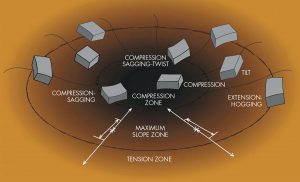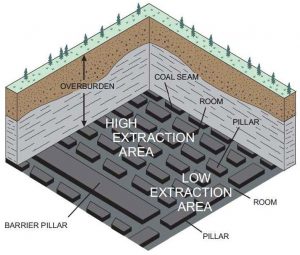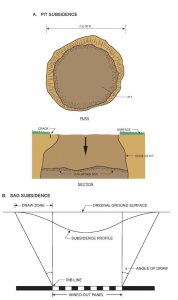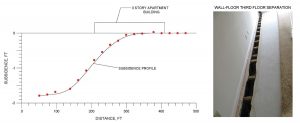When underground coal mining began in the 1700s in the U.S., many of the mines were located far away from developing city infrastructure. There was little thought of potential expansion over these mined-out areas or the effects of long-term subsidence. Until the 1970s, most mine design was essentially done by rule of thumb and focused on short-term operational needs. As cities began to expand into mined-out areas, city infrastructure became exposed to the risk of damage caused by mine subsidence. There are presently 17 states which have active and abandoned underground coal mines that require significant expenditures each year to address mine subsidence risk and damage.
Geologic Setting
In the U.S., coal beds lay relatively flat and are found in the bedrock between layers of mainly sandstone, shale, and limestone. In some regions of the U.S., there are multiple coal seams that have been mined. A coal seam is considered mineable by underground methods when it is at least 30 inches thick. Because of the number of mineable seams in West Virginia and Pennsylvania, these states contain the most areas with multiple coal workings.
Mining Methods
The underground mining of coal has evolved. Most older abandoned mines were developed using room-and-pillar methods. This method involved extracting the coal first by manual excavation and later by mechanical means. After coal extraction, this method left voided areas that contained unextracted coal (i.e. pillars) to support the mine roof and overburden. Over time, these pillars were more systematically placed. Figure 1 provides an illustration of room (void) and pillar (coal) workings. Although the pillars in the illustrations are prismatic in shape, they can be quite irregular and virtually any shape, especially in older mines. The amount of coal extracted with this method typically ranges from 60% to 75% by area.
A common high extraction method of coal mining used today is called longwall mining. This is a mechanized system of mining where 100% of the coal seam can be removed in up to typically 1,500-feet-wide by mile-long strips.
Mine Stability
The stability of the underlying room and pillar mine is directly related to the risk for future subsidence and the nature of the subsidence in the ground above. Consequently, the accuracy of these assessments plays a key role in determining proper land development decisions, such as how to avoid expensive subsidence mitigation or improper solutions, which can result in severe losses due to subsequent subsidence.
In assessing the risk of surface subsidence from an underlying coal mine, there are three basic modes of failure of the mine structure that should be evaluated.
- Mine-roof collapse into a mine opening,
- crushing of multiple mine pillars, and
- punching of multiple mine pillars into the mine floor.
Surface subsidence from the collapse of the mine roof occurs when upward caving in one of the mine rooms or room intersections breaches the bedrock surface. This phenomenon is also called chimney subsidence. The upward caving potential depends on the rock overburden conditions and the bulking or volume expansion of the caved material. The upward caving can be obstructed if a competent zone of rock in the overburden were able to bridge across the collapsed roof. Where no sufficiently competent rock zone exists, chimney subsidence will continue upwards until it breaches the bedrock surface, unless it chokes off.
The second mode of failure that results in surface subsidence is the yielding of the mine pillars or “pillar crushing.” This mode depends on the demand and capacity of the pillar.
The third mode of mine failure that can induce land subsidence is a mine-floor bearing failure. This phenomenon has also been termed “pillar punching” and “floor squeeze.” As with pillar crushing, several pillars must fail for significant subsidence to be realized on the ground surface. The potential for subsidence from a mine-floor failure depends on the loading on the pillar and the strength and durability of the floor materials. Pillar punching typically results when the mine floor is exposed to groundwater, dramatically reducing the overall floor bearing capacity. Another component that can compromise the floor strength is the presence of fissures in the rock.
Mine Subsidence Movements
Mine subsidence expresses itself on the ground surface in the form of pits (sinkholes) and sags or troughs. Pit subsidence exclusively occurs from chimney subsidence. This surface expression can range in size from a pothole to typically 30 feet in diameter and over 10 feet deep (Figure 2). These pits can extend to elongated-shaped sinkholes under very severe conditions.
Sag or trough subsidence expresses itself on the ground surface like a bowl- or swale-shaped depression. For room-and-pillar and high extraction mines, these expressions can range from one hundred to thousands of feet across with depths from 1 to 7 feet. The specific character of the sag or trough depends on the site conditions, most importantly:
- Mode of a mine failure
- Mine depth
- Mine layout
- Mining method
- Extraction height
- Soil and rock overburden
- Surface topography
Smaller sags occur at shallower mine depths and result from room roof collapse where the soil cover slumps into the breach in the bedrock. These events are usually circumscribed by faulted tension cracks on the ground surface. Although these sags are of smaller diameter, they can be quite deep at greater extraction heights and/or shallow mine depths or soil cover. Sags or troughs in the range of more than 300 feet to 800 feet across occur above room and pillar mines, are generally 1 to almost 4 feet deep, and are the result of multiple pillar deflections.
Larger subsidence events are caused by longwall mining. However, most of the movement from these events occur during mining, so there is some ability to implement mitigation measures where possible. These very long subsidence troughs occur sequentially and parallel to each other, with overlapping movements. Individual troughs are typically 4 to 6 feet deep and several thousands of feet across.
In addition to vertical surface deformations, sag/trough events induce differential horizontal displacements which result in centralized compressive zones and circumferential tension zones.
In relatively flat terrain, the maximum horizontal displacement for the larger subsidence events typically occurs in the direction of the bottom of the subsidence basin and is generally in the range of 10 to 30 percent of the maximum vertical movement. In rugged terrain, the horizontal displacements can be significantly more exacerbated and generally follow the direction of the steeper topography.
Subsidence-Structure Interaction
Given the risk of mine subsidence, the most important aspect of mine subsidence engineering is the estimation of structural response and associated damage. The general behavior of a surface structure to pit mine subsidence depends mainly on the nature of the structure and the subsidence characteristics. Pit subsidence under or in the vicinity of a building, if initially small or of pothole size, may result in no or slight damage. However, such an event would indicate that this area of ground is unstable and should be treated as a hazard because the pit can unpredictably expand at any given time until it is treated.
Larger pits or sinkholes that develop under buildings typically result in concentrated heavy damage to the foundation and superstructure (and can result in the collapse of a pole/column-supported structure). If the structure is small in comparison to the pit, the structure can become unrepairable. Once pit subsidence develops, it may move again (reactivate) in the future.
For sag subsidence, the estimation of structural response and associated damage requires a much greater understanding of a complex set of factors. The behavior of a surface structure with respect to sag subsidence depends on the nature of the structure, the ground conditions, and the subsidence characteristics. The nature and magnitude of the induced building deformation depend on the variation and magnitude of the ambient ground movement (controlled by the characteristics of the sag and the position of the structure within the sag). The induced deformation is also related to the construction of a proposed structure and the condition of an existing structure. Generally speaking, structures that are more flexible, simpler, and smaller react better to sag movements than large structures with rigid and fragile components, especially if the structure is complex and thus more susceptible to stress deformation concentrations. Consequently, even when impacted by the typical range of sag subsidence, structures such as wood barns, sheds, and smaller wood/metal warehouses (without floors) are likely to sustain only minor damage.

Figure 3. A sketch of some deformed flexible blocks resulting from a single sag event over an abandoned mine.
Figure 3 shows the full range of imposed structural deformations that can exist from the compression zone to the tension zone when the sag is large compared to the structure. The induced deformation is a function of the plan orientation, as well as the position of the structure on the sag (or trough) profile. Variations in the ground movement, as well as in construction, make the behavior difficult to model. The structural elements are rarely exposed to a purely two-dimensional state of stress. Moreover, where severe structural deformations are present, significant bending, shear, and tensile and/or compressive strains can be commonly found in the structure.
For any given subsidence basin, ground, and structure scenario, the relative size and location of the structure with respect to the sag determines the induced foundation strains/stresses and rigid body rotation. When structure area, S, versus the basin area, B, is small (e.g., up to about a small house for larger sags or trough), and assuming typical subsidence conditions, the structure will commonly lie in either the tension or compression zone and may be exposed to maximum slope effects. At small S/B ratios, the ambient ground movements are relatively two-dimensional in the tension zone, while ground deformations in the compression zone are commonly three-dimensional, even at small S/Bs. Structures that are relatively small with respect to the subsidence basin have the highest potential for rigid body tilt and translation. For intermediate values of S/B, the subsidence-structure interaction will most likely be more complicated. The structure can also span the slope zone, and both compressive and tensile damage can occur at opposite ends of the structure. At large S/B ratios (e.g. department store size), the foundation and superstructure response will usually be three-dimensional with compressive and tensile effects and include sagging unless the exposure to the basin is small enough under the structure that a “cantilevered” tensile condition may result.
As noted above, building response depends on several variables. However, based on the authors’ experience, noticeable damage can be expected to commence at angular distortion values of 1/250 to 1/300 with structural damage on the order of 1/150. An example is provided in Figure 4. In addition to other significant damage, Figure 4 shows the wall-floor of about 0.7 feet, which occurred in the middle of an apartment building, on the third floor, from hogging curvature of the subsidence profile. The angular distortion of the subsidence profile over the span of this building reached about 1/90.
Mitigation Measures
The subsidence damage risk can be controlled by taking surface and/or subsurface measures to reduce the potential damage. Surface measures include moving to a preferable structure orientation/location, earth pressure reduction design, stress/strain resistant and compliant design, and tilt accommodation. In most cases, however, the subsidence-resistant design is not the most cost-effective alternative when exposed to more typical movements. Where the potential subsidence damage risk is too great, the underlying mine workings can be stabilized. Mine stabilization via grouting can be done utilizing various methodologies ranging from significantly reducing to virtually eliminating any subsidence effects, at a significant difference in cost. Although relatively inexpensive for unit costs, mine stabilization can require massive grout quantities; 20,000 to 50,000 cubic yards is not uncommon.
Conclusion
In addressing construction above underground coal mines, questions that need to be answered are: What is the risk of subsidence over the lifespan of the structure? What is the amount of movement that can occur? What is the potential damage? What can be done to mitigate the risk? The risk decision-making process involves understanding and evaluating the likelihood of subsidence and associated consequences. Therefore, given the investment, having correct risk information is critical to proper decision making.■



